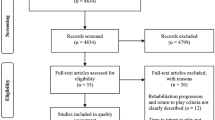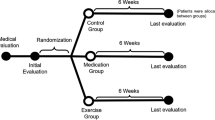Abstract
Our objectives were: (1) to assess the relationship between self-reported measures (Western Ontario and McMaster University Osteoarthritis Index (WOMAC) and Medical Outcomes Study Short Form-36 (SF-36)) and a performance-based timed-up-and-go (TUG) test in a hip and knee joint replacement population and (2) to determine the predictors of postoperative functional status as measured by the 12-week WOMAC and TUG scores. We surveyed 200 patients undergoing primary hip or knee replacement surgery for demographic data and outcome scores at baseline and 12-week follow-up. There was a weak correlation between preoperative TUG scores and preoperative SF-36 physical function scores (r = −0.28, p < 0.0001), SF-36 role-physical scores (r = −0.21, p = 0.0022) and WOMAC (r = 0.29, p < 0.0001) scores. The relationship was stronger between the postoperative TUG scores and WOMAC scores (r = 0.43, p < 0.0001), SF-36 physical function scores (r = −0.39, p < 0.0001) and SF-36 role-physical (r = −0.33, p < 0.0001) scores. Significant predictors for the TUG test at 12-week follow-up were age (p = 0.004) and preoperative TUG scores (p < 0.0001). Given low-to-moderate relationship between self-reported and performance-based tools, both tests are needed to assess the true level of patient disability.
Similar content being viewed by others
References
Ethgen O, Bruyère O, Richy F et al (2004) Health-related quality of life in total hip and total knee arthroplasty. A qualitative and systematic review of the literature. J Bone Jt Surg Am 86(5):963–974
Räsänen P, Paavolainen P, Sintonen H et al (2007) Effectiveness of hip or knee replacement surgery in terms of quality-adjusted life years and costs. Acta Orthop 78(1):108–115
Dixon T, Shaw M, Ebrahim S et al (2004) Trends in hip and knee joint replacement: socioeconomic inequalities and projections of need. Ann Rheum Dis 63(7):825–830
Holtzman J, Saleh K, Kane R (2002) Effect of Baseline Functional status and pain on outcomes of total hip. J Bone Jt Surg Am 84(11):1942–1948
Ostendorf M, Buskens E, van Stel H (2004) Waiting for total hip arthroplasty: avoidable loss in quality time and preventable deterioration. J Arthroplast 19(3):302–309
Lingard EA, Katz JN, Wright EA et al (2004) Predicting the outcome of total knee arthroplasty. J Bone Jt Surg Am 86(10):2179–2186
Fortin PR, Clarke AE, Joseph L et al (1999) Outcomes of total hip and knee replacement: preoperative functional status predicts outcomes at six months after surgery. Arthritis Rheum 42:1722–1728
Fortin PR, Penrod JR, Clarke AE et al (2002) Timing of total joint replacement affects clinical outcomes among patients with osteoarthritis of the hip or knee. Arthritis Rheum 46:3327–3330
Bellamy N, Buchanan WW, Goldsmith CH et al (1988) Validation study of WOMAC: a health status instrument for measuring clinically-important patient relevant outcomes following total hip or knee arthroplasty in osteoarthritis. J Rheumatol 15:1833–1840
Ware JE Jr, Sherbourne CD (1992) The MOS 36-item short-form health survey (SF-36). I. Conceptual framework and item selection. Med Care 30:473–483
Podsiadlo D, Richardson S (1991) The timed “up & go”: A test of basic functional mobility for frail elderly persons. J Am Geriatr Soc 39:142–148
Guyatt GH, Sullivan MJ, Thompson PJ et al (1985) The 6-minute walk: a new measure of exercise capacity in patients with chronic heart failure. Can Med Assoc J 132:919–923
Lingard EA, Katz JN, Wright RJ et al (2001) Validity and responsiveness of the Knee Society Clinical Rating System in comparison with the SF-36 and WOMAC. J Bone Jt Surg Am 83-A(12):1856–1864
Bombardier C, Melfi CA, Paul J et al (1995) Comparison of a generic and a disease-specific measure of pain and physical function after knee replacement surgery. Med Care 33(4 Suppl):AS131–AS144
Kosinski M, Keller SD, Hatoum HT et al (1999) The SF-36 Health Survey as a generic outcome measure in clinical trials of patients with osteoarthritis and rheumatoid arthritis: tests of data quality, scaling assumptions and score reliability. Med Care 37(5 Suppl):MS10–MS22
Brazier JE, Harper R, Munro J et al (1999) Generic and condition-specific outcome measures for people with osteoarthritis of the knee. Rheumatology (Oxford) 38:870–877
Bischoff HA, Stahelin HB, Monsch AU et al (2003) Identifying a cut-off point for normal mobility: a comparison of the timed ‘up and go’ test in community-dwelling and institutionalised elderly women. Age Ageing 32:315–320
Angel R, Ostir GV, Frisco ML et al (2000) Comparison of a self-reported and a performance-based assessment of mobility in the hispanic established population for epidemiological studies of the elderly. Res Aging 22:715–737
Kennedy D, Stratford PW, Pagura SM et al (2002) Comparison of gender and group differences in self-report and physical performance measures in total hip and knee arthroplasty candidates. J Arthroplast 17:70–77
Parent E, Moffet H (2002) Comparative responsiveness of locomotor tests and questionnaires used to follow early recovery after total knee arthroplasty. Arch Phys Med Rehabil 83:70–80
Cress ME, Schechtman KB, Mulrow CD et al (1995) Relationship between physical performance and self-perceived physical function. J Am Geriatr Soc 43:93–101
Finch E, Walsh M, Thomas SG et al (1998) Functional ability perceived by individuals following total knee arthroplasty compared to age-matched individuals without knee disability. J Orthop Sports Phys Ther 27:255–263
Boardman DL, Dorey F, Thomas BJ et al (2000) The accuracy of assessing total hip arthroplasty outcomes: a prospective correlation study of walking ability and 2 validated measurement devices. J Arthroplast 15:200–204
Mahomed NN, Davis A, Hawker G et al (2008) Inpatient compared with home-based rehabilitation following primary unilateral total hip or knee replacement: a randomized controlled trial. J Bone Jt Surg Am 90:1673–1680
Linn BS, Linn MW, Gurel L (1968) Cumulative illness rating scale. J Am Geriatr Soc 16:622–626
Miller MD, Paradis CF, Houck PR et al (1992) Rating chronic medical illness burden in geropsychiatric practice and research: application of the cumulative illness rating scale. Psychiatry Res 41:237–248
Shumway-Cook A, Brauer S, Woollacott M (2000) Predicting the probability for falls in community-dwelling older adults using the Timed up and go test. Phys Ther 80:896–903
Cohen J (1988) Statistical power analysis for the behavioral sciences, 2nd edn. Lawrence Erlbaum, Hillsdale
Hoeymans N, Wouters ER, Feskens EJ et al (1997) Reproducibility of performance-based and self-reported measures of functional status. J Gerontol A Biol Sci Med Sci 52:M363–M368
Watson D, Pennebaker JW (1989) Health complaints, stress and distress: exploring the central role of negative affectivity. Psychol Rev 96:234–254
Myers AM, Holliday PJ, Harvey KA et al (1993) Functional performance measures: are they superior to self-assessments? J Gerontol 48:M196–M206
Sager MA, Dunham NC, Schwantes A et al (1992) Measurement of activities of daily living in hospitalized elderly: a comparison of self-report and performance-based methods. J Am Geriatr Soc 40:457–462
Kennedy DM, Hanna SE, Stratford PW et al (2006) Preoperative function and gender predict pattern of functional recovery after hip and knee arthroplasty. J Arthroplast 21:559–66
Kennedy DM, Stratford PW, Hanna SE et al (2006) Modeling early recovery of physical function following hip and knee arthroplasty. BMC Musculoskelet Disord 11(7):100
Disclosures
None
Author information
Authors and Affiliations
Corresponding author
Rights and permissions
About this article
Cite this article
Gandhi, R., Tsvetkov, D., Davey, J.R. et al. Relationship between self-reported and performance-based tests in a hip and knee joint replacement population. Clin Rheumatol 28, 253–257 (2009). https://doi.org/10.1007/s10067-008-1021-y
Received:
Revised:
Accepted:
Published:
Issue Date:
DOI: https://doi.org/10.1007/s10067-008-1021-y




